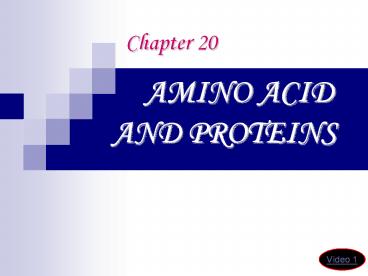AMINO ACID AND PROTEINS - PowerPoint PPT Presentation
1 / 26
Title:
AMINO ACID AND PROTEINS
Description:
Zwitterion ... dipolar ion / zwitterion. The dipolar nature of amino acids give to. their ... zwitterion is electrically neutral and exists at specific pH. ... – PowerPoint PPT presentation
Number of Views:312
Avg rating:3.0/5.0
Title: AMINO ACID AND PROTEINS
1
Chapter 20
- AMINO ACID AND PROTEINS
Video 1
2
20 .1 INTRODUCTION
amino acid
amino group NH2
carboxyl group -COOH
Video 2
3
- Amino acids can join together into long chains by
forming amide bonds between the NH2 of one amino
acid and the COOH of another - peptides - chains with fewer than 50
- amino acids
- protein is reserved for longer chains.
4
- Amino acids commonly found in proteins are
?-amino acid, meaning that the amino group in
each is a substituent on the ? carbon atom - ? carbon atom the one next to
- the carbonyl group.
5
General structure of ?-amino acid
6
E
X
A
M
P
L
E
7
- The hydrogen atom and R group are attached to ?
carbon - The differences of R group in each amino acid
give the unique characteristic of the amino
acids. - There are 20 different amino acids commonly found
incorporated into proteins.
Video 3
8
Classification of 20 Amino Acids in Protein.
9
(No Transcript)
10
(No Transcript)
11
(No Transcript)
12
(No Transcript)
13
(No Transcript)
14
(No Transcript)
15
Naming Amino Acids
- The carboxyl group as the parent name whereas
amino group as substituent group - Alanine
- CH3 CH COOH
- NH2
Common name
2
1
3
2-amino
propanoic acid
Video 4
16
Example
Serine
2-amino-3-hydroxypropanoic acid
17
Example
Aspartic acid
HOOC CH2 CH COOH
NH2
2-aminobutanedioic acid
18
Example
Lysine
H2N CH2CH2CH2CH2 CH COOH
NH2
2,6-diaminohexanoic acid
19
Physical Properties
- Amino acids can undergo an internal acid-base
reaction, in which a proton is transferred from
the carboxyl to the amino group to form dipolar
ion called zwitterion.
Video 5
20
Zwitterion
- a form in which the carboxyl group is present as
a carboxylate ion, -CO2- , and the amino group is
present as an aminium ion, -NH3
Video 6
21
Uncharged structure
dipolar ion / zwitterion
22
- The dipolar nature of amino acids give to
- their unique properties-
- Amino acids have high melting points, generally
over 2000C. - Amino acids are more soluble in water.
- Amino acids are amphoteric or ampholite (
amphoteric electrolyte ) which - can react as acid or base
- depending on the pH of
- the solution
23
OH-
OH-
H
H
Acid
pHpI
base
cation
zwitterion
anion
Amino acids as acid
Amino acids as amphoteric
Amino acids as base
24
- In acidic solutions all amino acids are present
primarily as cations (amino acids are base). - In basic solutions they are
- present as anions (amino acids
- are acid).
25
Isoelectric point (pI)
- zwitterion is electrically neutral and exists at
specific pH. This particular pH is called
isoelectric points. - Each amino acid has its specific isoelectric
point. - For example , isoelectric point,
- pI - alanine is at pH 6.02.
- At this pH, alanine exists as
- zwitterions.
Video 7
26
Exercise
- The isoelectric point for Lysine (
2,6-diaminohexanoic acid ) is 9.5. - Draw the structural formulae for Lysine at
- (i) pH 1 (ii) pH 9.5 (iii) pH 12































